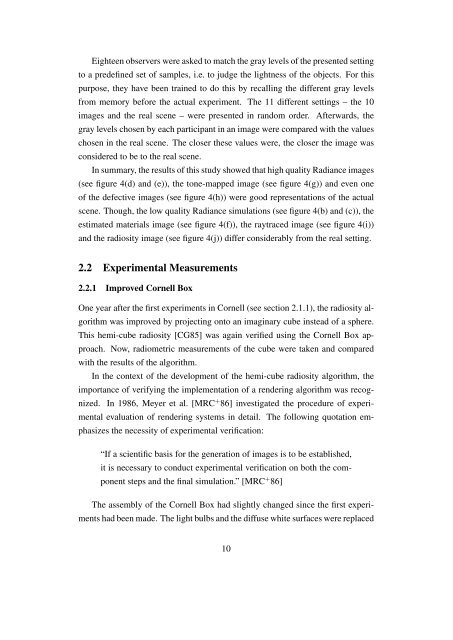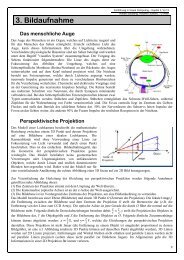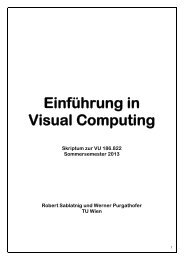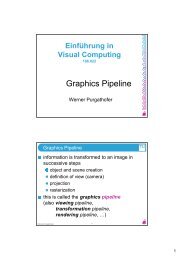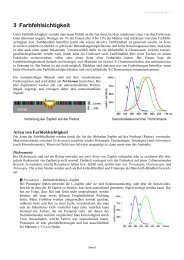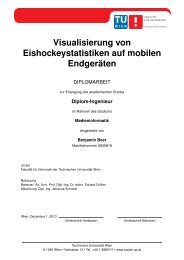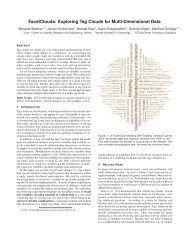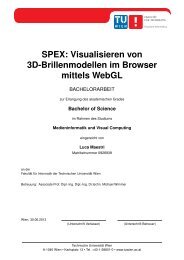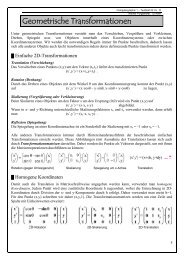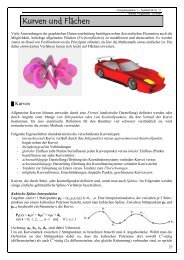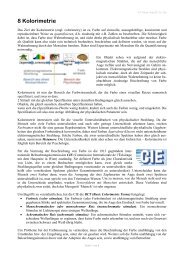Usability of Digital Cameras for Verifying Physically Based ...
Usability of Digital Cameras for Verifying Physically Based ...
Usability of Digital Cameras for Verifying Physically Based ...
Create successful ePaper yourself
Turn your PDF publications into a flip-book with our unique Google optimized e-Paper software.
Eighteen observers were asked to match the gray levels <strong>of</strong> the presented setting<br />
to a predefined set <strong>of</strong> samples, i.e. to judge the lightness <strong>of</strong> the objects. For this<br />
purpose, they have been trained to do this by recalling the different gray levels<br />
from memory be<strong>for</strong>e the actual experiment. The 11 different settings – the 10<br />
images and the real scene – were presented in random order. Afterwards, the<br />
gray levels chosen by each participant in an image were compared with the values<br />
chosen in the real scene. The closer these values were, the closer the image was<br />
considered to be to the real scene.<br />
In summary, the results <strong>of</strong> this study showed that high quality Radiance images<br />
(see figure 4(d) and (e)), the tone-mapped image (see figure 4(g)) and even one<br />
<strong>of</strong> the defective images (see figure 4(h)) were good representations <strong>of</strong> the actual<br />
scene. Though, the low quality Radiance simulations (see figure 4(b) and (c)), the<br />
estimated materials image (see figure 4(f)), the raytraced image (see figure 4(i))<br />
and the radiosity image (see figure 4(j)) differ considerably from the real setting.<br />
2.2 Experimental Measurements<br />
2.2.1 Improved Cornell Box<br />
One year after the first experiments in Cornell (see section 2.1.1), the radiosity al-<br />
gorithm was improved by projecting onto an imaginary cube instead <strong>of</strong> a sphere.<br />
This hemi-cube radiosity [CG85] was again verified using the Cornell Box ap-<br />
proach. Now, radiometric measurements <strong>of</strong> the cube were taken and compared<br />
with the results <strong>of</strong> the algorithm.<br />
In the context <strong>of</strong> the development <strong>of</strong> the hemi-cube radiosity algorithm, the<br />
importance <strong>of</strong> verifying the implementation <strong>of</strong> a rendering algorithm was recog-<br />
nized. In 1986, Meyer et al. [MRC + 86] investigated the procedure <strong>of</strong> experi-<br />
mental evaluation <strong>of</strong> rendering systems in detail. The following quotation em-<br />
phasizes the necessity <strong>of</strong> experimental verification:<br />
“If a scientific basis <strong>for</strong> the generation <strong>of</strong> images is to be established,<br />
it is necessary to conduct experimental verification on both the com-<br />
ponent steps and the final simulation.” [MRC + 86]<br />
The assembly <strong>of</strong> the Cornell Box had slightly changed since the first experi-<br />
ments had been made. The light bulbs and the diffuse white surfaces were replaced<br />
10


